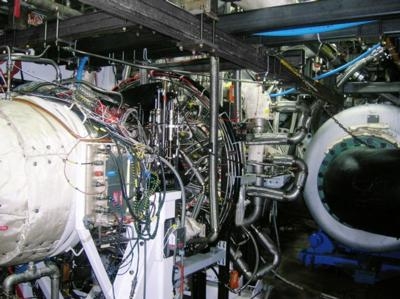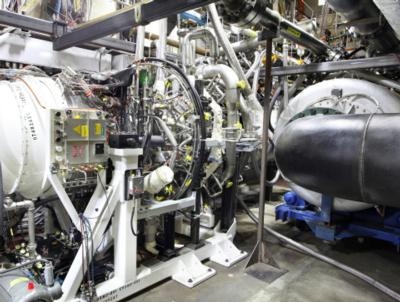Mon, Oct 15, 2012
ADVENT Program In Conjunction With The U.S. Air Force Research Laboratory
Engine core testing for the ADaptive Versatile ENgine Technology (ADVENT) program with the U.S. Air Force Research Laboratory is underway at GE Aviation’s headquarters in Evendale, Ohio. The core test demonstrates GE’s most advanced core propulsion technologies including lightweight, heat-resistant ceramic matrix composite (CMC) materials. These core technologies, along with an adaptive low pressure spool, will result in a 25 percent improvement in fuel efficiency, a 30 percent increase in operating range and a five-to-ten percent improvement in thrust compared to today’s fixed-cycle engines.

The ADVENT program is scheduled to conclude in 2013 with a full engine test. GE will continue to mature the ADVENT technologies through the Air Force’s Adaptive Engine Technology Development (AETD) program, which will conclude in 2016 following fan rig testing and a core engine test.
“The ADVENT engine is a revolutionary military engine,” said Jeff Martin, GE Aviation’s general manager for the ADVENT program. “Packaged together, GE’s variable-pressure-ratio fan, CMC materials and high-pressure-ratio core technologies will enable the Air Force to meet the aggressive performance targets required for future missions.”
“GE Aviation is honored to partner with the Air Force in the demonstration of these unique technologies,” said Dan McCormick, GE Aviation’s general manager for the AETD program. “Along with advanced controls and exhaust system designs, we will integrate proven ADVENT technologies like third-stream cooling and CMCs into our AETD engine.”
Unlike fixed cycle engine architectures powering today’s aircraft, variable cycle architectures are designed to operate efficiently in conditions across the entire flight envelope, including subsonic and supersonic speeds. GE’s adaptive cycle design includes a third stream of air that can be utilized for maximum fuel efficiency while providing thermal management advantages to a conventional engine.

The ADVENT engine is GE Aviation’s most recent development program to successfully demonstrate the variable cycle architecture. Following initial studies by Gerhard Neumann in the 1960s, GE’s YJ101 was the first full engine to demonstrate variable cycle capabilities in 1976. GE built on the YJ101 experience to produce the YF120 variable cycle engine for the Advanced Tactical Fighter project, which set the world supercruise record in 1990.
The ADVENT and AETD variable cycle engines are improving on the YF120 design while integrating technologies developed through GE Aviation’s $600 million investment in commercial engine programs, such as high pressure compressors and lightweight CMCs in the high- and low-pressure turbines that result in reduced engine weight and minimize the need for cooling. The ADVENT engine will be GE’s highest overall pressure ratio military engine, resulting in a significant fuel consumption improvement compared to today’s engines.
(Images provided by GE Aviation)
More News
The Industry Continues to be Rocked By Some Questionable Operations Recent investigations and a great deal of data has resulted in ANN’s SportPlane Resource Guide’s rep>[...]
Make Sure You NEVER Miss A New Story From Aero-News Network Do you ever feel like you never see posts from a certain person or page on Facebook or Instagram? Here’s how you c>[...]
Visual Approach Slope Indicator (VASI) An airport lighting facility providing vertical visual approach slope guidance to aircraft during approach to landing by radiating a directio>[...]
Airport Marking Aids Markings used on runway and taxiway surfaces to identify a specific runway, a runway threshold, a centerline, a hold line, etc. A runway should be marked in ac>[...]
Aero Linx: The Skyhawk Association The Skyhawk Association is a non-profit organization founded by former Skyhawk Pilots which is open to anyone with an affinity for the A-4 Skyhaw>[...]
 Unfortunate... ANN/SportPlane Resource Guide Adds To Cautionary Advisories
Unfortunate... ANN/SportPlane Resource Guide Adds To Cautionary Advisories ANN FAQ: Turn On Post Notifications
ANN FAQ: Turn On Post Notifications ANN's Daily Aero-Term (04.29.24): Visual Approach Slope Indicator (VASI)
ANN's Daily Aero-Term (04.29.24): Visual Approach Slope Indicator (VASI) ANN's Daily Aero-Term (04.28.24): Airport Marking Aids
ANN's Daily Aero-Term (04.28.24): Airport Marking Aids ANN's Daily Aero-Linx (04.28.24)
ANN's Daily Aero-Linx (04.28.24)




